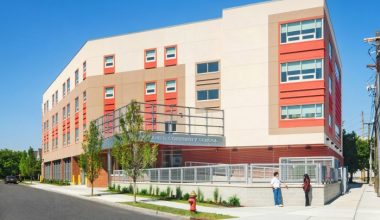Getting across unfamiliar educational system especially in a foreign country, can be quite challenging. You will always notice a significant difference in the terminologies used and it can create misunderstanding if not explained.
It may surprise you to know that high school is called something different in England. So the question is What is High School Called in England? That’s the puzzle this writing will solve.
The British school system is reputed for its rich history, unique approach to learning and different terminologies used to identify each stage of schooling, which is entirely different from that of the United States. This can be a major challenge for those who are unfamiliar with what a High School is Called in England.
In this writing, we will bridge that gap in understanding and explain in details, what a High School is Called in England and all you need to know about the English education stages and system.
Table of contents
- What is High School Called in England?
- What are the Stages of Education in the UK?
- How does the British education system differ from other systems around the world?
- What are the Main Differences Between Primary and Secondary Education?
- How is the transition from primary to secondary education managed in the UK?
- What are some standardized exams students take during their secondary education?
- General Certificate of Secondary Education (GCSE):
- Advanced Level (A-level):
- International Baccalaureate (IB):
- Scottish Qualifications Authority (SQA) Exams (Scotland):
- Vocational Qualifications (BTEC, NVQ, etc.):
- Standardized English Language Proficiency Exams:
- National Admissions Tests for University (e.g., BMAT, UKCAT, LNAT):
- Other Qualifications and Assessments:
- What are GCSEs and A-levels, and how do they fit into the British education system?
- Conclusion
- Frequently Asked Questions
- References
- Recommendations
What is High School Called in England?
In England, what is commonly called “high school” in other countries is known as “secondary school.” Secondary school is the educational institution that students attend after completing primary school.
This stage of education is a critical phase in a student’s academic journey, typically catering to students aged 11 to 16 years old.
It covers Key Stage 3 (ages 11-14) and Key Stage 4 (ages 14-16), where students study a range of subjects and often prepare for critical standardized exams such as the General Certificate of Secondary Education (GCSE) examinations.
The term “secondary school” encompasses diverse schools, including comprehensive schools, grammar schools, academies, and more, offering various approaches to education and catering to different student needs.
Check out this related content: 10 Best Laundry Bags for Your College Dorm in 2024
What are the Stages of Education in the UK?
The education system in the United Kingdom is typically divided into several key stages, each representing a distinct phase of a student’s academic journey. These stages encompass different age ranges and educational focuses. The critical stages of education in the UK are as follows:
Early Years Foundation Stage (EYFS):
Age Range: 0-5 years
This stage focuses on early childhood education and development, laying the foundation for future learning. It includes nurseries, preschools, and reception classes in primary schools.
Primary Education:
Age Range: 5-11 years
Primary education includes Key Stage 1 (ages 5-7) and Stage 2 (ages 7-11). Students learn various subjects, including English, mathematics, science, history, geography, art, music, and physical education.
Secondary Education:
Age Range: 11-16 years
Secondary education comprises Key Stage 3 (ages 11-14) and Key Stage 4 (ages 14-16). Students continue their education in a more specialized manner, studying subjects like mathematics, science, languages, humanities, and creative arts. Key Stage 4 often culminates in GCSE examinations.
Post-16 Education:
Age Range: 16-18 years
After completing their GCSEs, students can choose to continue their education in post-16 institutions. This stage includes options such as A-levels, vocational qualifications, apprenticeships, and college courses. A-levels are specialized qualifications often required for university admission.
Higher Education:
Age Range: 18+ years
Higher education involves pursuing university degrees and other tertiary qualifications. Students can enroll in undergraduate (bachelor’s) and postgraduate (master’s and doctoral) programs in universities and colleges across the UK.
You should read How to Pay Off Your Student Loans in 5 Years: A Step-by-Step Guide.
How does the British education system differ from other systems around the world?
The British education system has distinct features that set it apart from education systems in other parts of the world. Some key differences include the following:
Specialization at an Early Age
In the British system, students begin to specialize in subjects at an earlier age compared to some other systems. For example, students in England often choose their GCSE subjects around 14, whereas, in some other countries, students maintain a more generalized curriculum until later stages.
Standardized Examinations (GCSEs and A-levels)
The British education system places significant emphasis on standardized examinations. Students take General Certificate of Secondary Education (GCSE) exams at the end of Key Stage 4 and Advanced Level (A-level) exams after post-16 education. These exams play a crucial role in university admissions.
Uniforms and House System
Many British schools, especially in England, have a tradition of wearing uniforms. The “house system” is also prevalent in schools, where students are divided into different houses for competitions, events, and pastoral care.
Grammar Schools and Comprehensive Schools
The UK has a unique system of grammar schools, which admit students based on academic performance, and comprehensive schools, which admit students regardless of their abilities. This distinction is less common in many other countries.
Boarding Schools
Boarding schools are a significant part of the British education system, offering students the option to live on campus. This concept is rare in some other countries.
Diverse Curricula
In some countries, curricula are more centralized and standardized across the nation. In the UK, there’s a degree of flexibility, allowing schools to make confident choices regarding curriculum content and teaching methods.
Also, check out this content: What is the NMQST, and Why is it so Important?
What are the Main Differences Between Primary and Secondary Education?
Primary Education:
Curriculum:
The primary education curriculum is generally broader and covers various subjects, including English, mathematics, science, history, geography, art, music, physical education, and sometimes religious education.
The focus is on building foundational skills and knowledge in various areas to provide a well-rounded education.
Teaching Methods:
Teaching in primary schools often involves a more generalist approach, with one teacher responsible for leading multiple subjects to the same group of students.
Learning is typically interactive, emphasizing hands-on activities, group work, and play-based learning for younger students.
Student Expectations:
Primary students develop fundamental literacy and numeracy skills.
Social skills, teamwork, and basic communication skills are also important, fostering a love for learning and curiosity.
Secondary Education:
Curriculum:
The secondary education curriculum becomes more specialized, allowing students to choose subjects based on their interests and aptitudes. These subjects include mathematics, sciences, languages, humanities, and creative arts.
There’s a transition from a broad curriculum to a more in-depth study of selected subjects.
Teaching Methods:
Secondary education involves subject-specific teachers who often specialize in their respective fields.
Teaching methods may include lectures, class discussions, projects, and independent research and study.
Student Expectations:
Students take greater ownership of their learning and manage their time and assignments more independently.
As they progress, students prepare for standardized exams (e.g., GCSEs) that significantly influence their educational trajectory.
Check out this related content: What you should know about Student Loan “Principal Balance?’
How is the transition from primary to secondary education managed in the UK?
The transition from primary to secondary education in the UK is a significant milestone for students. They manage it through a combination of strategies and practices. Here’s how the transition process is handled:
Primary to Secondary School Transition Programs:
Many secondary schools have established transition programs to ease the process for incoming students. These programs often include open days, information sessions, and tours for students and parents to familiarize themselves with the new school environment.
Communication between Schools:
The primary schools and secondary schools communicate to share important information about students’ academic progress, achievements, and any additional support needs.
Primary School Recommendations:
Primary schools often recommend subject choices based on students’ strengths and interests. This information assists secondary schools in placing students in appropriate classes and setting initial targets.
Induction Days and Events:
Secondary schools typically organize induction days or events where incoming students spend a day at their new school. These events introduce students to the school layout, facilities, teachers, and fellow students, helping to alleviate anxiety and build familiarity.
Support Staff and Mentoring:
Many schools assign mentors or older students (peer mentors) to guide incoming students during their first weeks at secondary school. This support system offers assistance with navigating the new environment and addressing any concerns.
Orientation and Parental Involvement:
Parental involvement is encouraged through orientation sessions and parent-teacher meetings. These interactions allow parents to learn more about the secondary school’s expectations and policies.
Inclusion of SEN (Special Educational Needs) Students:
For students with special educational needs, additional transition support is provided. This might involve arranging meetings with special educational needs coordinators and ensuring that necessary accommodations are in place.
Also, check out this content: How to Submit the FAFSA To More Than 10 Colleges.
What are some standardized exams students take during their secondary education?
During their secondary education in the UK, students take several important standardized exams that significantly assess their academic progress, determine educational pathways, and prepare them for further studies or employment. Some of the key standardized exams include:
General Certificate of Secondary Education (GCSE):
Taken at the end of Key Stage 4 (ages 14-16).
Students typically take GCSE exams in multiple subjects, which include core subjects like English, mathematics, and science, as well as optional issues of their choice.
GCSE results are used for university admissions, college applications, and job opportunities.
Advanced Level (A-level):
Taken after completing post-16 education (ages 16-18).
A-level exams are subject-specific and are typically taken in the final year of secondary education.
A-level results play a crucial role in determining university admissions. Students choose their A-level subjects based on their intended degree courses.
Also, check out this content: 10 Smart Questions to Ask on a College Tour | Act Smart
International Baccalaureate (IB):
Offered as an alternative to A-levels for students seeking an internationally recognized qualification.
The IB program includes a broader curriculum with six subject areas and additional components like the Theory of Knowledge (TOK) and the Extended Essay.
Students in Scotland take a range of National 4, National 5, Higher, and Advanced Higher exams.
These exams are part of the Scottish education system and are for university admissions in Scotland and the rest of the UK.
Vocational Qualifications (BTEC, NVQ, etc.):
Students pursuing vocational pathways may take vocational qualifications such as BTEC (Business and Technology Education Council) and NVQ (National Vocational Qualification).
These qualifications focus on practical skills and help to enter specific industries or professions.
Also, check out this content: What If My Family Can’t Meet Our EFC? Best Alternative.
Standardized English Language Proficiency Exams:
For non-native English speakers, exams like the International English Language Testing System (IELTS) or Test of English as a Foreign Language (TOEFL) may be a requirement for university admissions.
National Admissions Tests for University (e.g., BMAT, UKCAT, LNAT):
Some competitive degree programs, like medicine, law, and particular sciences, require students to take specific admissions tests in addition to their regular qualifications.
Other Qualifications and Assessments:
Depending on their interests and educational paths, students might take additional exams or assessments relevant to their chosen subjects or career aspirations.
You should read: 10 Best Naval Architecture Schools in 2024 | Admission, Cost
What are GCSEs and A-levels, and how do they fit into the British education system?
GCSEs (General Certificate of Secondary Education):
GCSEs are exams for students in the UK at the end of Key Stage 4, usually around the age of 16. These exams cover a range of subjects and play a significant role in assessing students’ academic achievements, determining their eligibility for further education or employment opportunities, and shaping their future educational pathways. Some key points about GCSEs include:
Subjects and Flexibility
Students typically take a variety of GCSE subjects, including core subjects like English, mathematics, and science, as well as optional subjects like history, geography, languages, arts, and more. The flexibility to choose topics allows students to focus on areas of interest or potential career paths.
Assessment Methods
Depending on the subject, GCSE exams may include written exams, coursework, practical assessments, and oral examinations. The assessment methods vary based on the subject’s requirements.
Grading System
GCSEs have their grades on a scale from 9 to 1 (with 9 being the highest grade). A grade of 4 is a “standard pass,” and a grade of 5 is a “strong pass.” The grading system helps universities and employers gauge a student’s academic performance.
Importance
GCSE results are crucial for determining students’ eligibility for further education options, including A-levels, vocational courses, and apprenticeships. They also influence university admissions, job applications, and career prospects.
A-levels (Advanced Level):
A-levels are advanced qualifications typically taken by students in the UK after completing their GCSEs. It provides a more specialized and in-depth study of subjects and is commonly required for university admissions. Here are some key features of A-levels:
Subject Specialization
Students typically choose three to four A-level subjects based on their academic interests and intended university degree courses. A-levels allow students to focus on subjects that align with their future career goals.
Two-Year Course
Students usually complete A-levels over two years, often called the “sixth form” years of secondary education.
Assessment Methods
A-level assessments are primarily based on written exams, although some subjects may include practical assessments, coursework, and oral examinations. The exams are usually taken at the end of the two-year course.
Grading System
A-levels are graded on a scale from A* (highest) to E (lowest). The grades reflect a student’s performance in the exams.
University Admissions
A-level results are a key factor in university admissions. Universities make offers based on predicted A-level grades, and final offers are often contingent upon achieving those grades.
Also, check out this content: Top Companies That Offer Tuition Reimbursement to Students in 2024
Conclusion
Learning educational jargon different from yours can be a huge task. While High school is known in England, the more appropriate term for this level of academic study is Secondary School. When you understand this uniqueness, the communication gap can be bridged and you will be able to appreciate the unique educational structures around the globe fully.
Check out this related content: 10 Best Laundry Bags for Your College Dorm in 2024
Frequently Asked Questions
In the British education system, what is commonly referred to as “high school” in other countries is known as “secondary school” in England
Unlike some other education systems, British secondary education is typically divided into two key phases: Key Stage 3 (ages 11-14) and Key Stage 4 (ages 14-16).
GCSEs (General Certificate of Secondary Education) are a set of standardized exams students take at the end of Key Stage 4. These exams cover a range of subjects and serve as an essential foundation for further education or employment.
Yes, there are various types of secondary schools in England, each with unique characteristics. These include comprehensive schools, which admit students regardless of ability; grammar schools, which select students based on academic performance; and academies.
While academics are central in the British education system, extracurricular activities are vital in fostering holistic development. Secondary schools in England offer a range of extracurricular activities, such as sports, arts, clubs, and societies.
References
- internations.org- what is a high school called in England
- brightworldguardianships.com– what is the high school called in England
- internationalstudent.com– what is high school called in England





